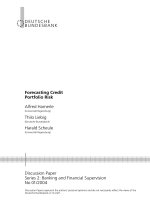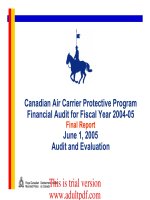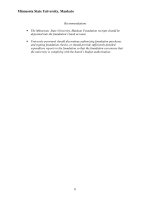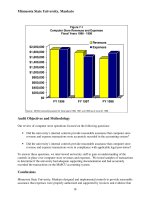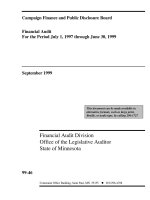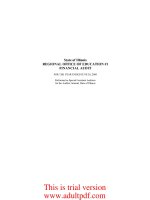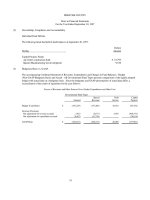Financial information for managemetn paper 1 2 2003 p2 answer
Bạn đang xem bản rút gọn của tài liệu. Xem và tải ngay bản đầy đủ của tài liệu tại đây (113.64 KB, 13 trang )
Answers
Part 1 Examination – Paper 1.2
Financial Information for Management
1
C
2
B
3
D
4
C
5
B
6
7
A
D
June 2003 Answers
Marginal costing profit
Less: fixed costs in opening stock
(300 x £5)
Add: fixed costs in closing stock
(750 x £5)
£72,300
(£1,500)
£3,750
––––––––
£74,550
––––––––
£315
––––– x 117 = £235
157
Price variance
Did cost
Should cost
(53,000 kg x £2·50)
£136,000
£132,500
–––––––––––––
£3,500 adverse
–––––––––––––
Usage variance
Did use
Should use
(27,000 units x 2 kg)
53,000 kg
54,000 kg
–––––––––
1,000 kg
x £2·50
£2,500 favourable
––––––––––––––––
Sales
Less: opening stock
Add: closing stock
(5% x 10,000)
10,000 units
(600 units)
500 units
––––––––––
9,900 units
Good production required
Good production = 90% of total production, therefore
9,900
Total production = –––––– = 11,000 units
90%
8
B
9
C
Total Contribution = (£10 – £6) x 250,000 = £1,000,000
Fixed Overheads = 200,000 x £2 = £400,000
Profit = Total contribution less fixed costs
= £1,000,000 – £400,000 = £600,000
19
10 A
Process
Units
400
3,000
Opening stock
Input
Losses
Output
Closing stock
––––––
3,400
––––––
––––––
11 C
1⋅ 00560 – 1
5×
= £348 ⋅ 85 ≈ £349
0 ⋅ 005
12 D
13 D
14 A
150,000 + 75,000
––––––––––––––––––
0·75
300,000
–––––––
£10
= £300,000
Breakeven revenue
= 30,000 units
∑y
∑x
−b
n
n
200
5 ⋅ 75
a=
– (17 ⋅ 14 ×
) = 25 ⋅ 36
4
4
a=
15 B
Lower of
replacement cost
£105,000
higher of
NRV
75,000
Economic value
90,000
16 A
17 C
18 A
Residual income for the division = £120,000 – (£650,000 x 18%)
Residual income = £3,000
19 A
20 B
Total material required =
36
24
15
(2,000 x ––) + (1,500 x ––) + (4,000 x ––) = 28,000 kg
6
6
6
21 C
Total cost of having stock =
D
Q
(p x D) + (–– x Co) + (Ch x ––)
Q
2
20,000
500
= (40 x 20,00) + (–––––– x 25) + (4 x ––– )
500
2
= 800,000 + 1,000 + 1,000 = 802,000
22 D
20
Units
400
2,800
200
––––––
3,400
––––––
––––––
23 A
As advertising will hopefully generate sales, advertising is the independent variable and sales the dependent; i.e. advertising
is x and sales is y.
225,000 = a + (6,500 x b)
125,000 = a + (2,500 x b)
–––––––– ––––––––––––––
100,000 = 0 + (4,000 x b)
100,000
therefore b = –––––––
4,000
= £25
so, 225,000 = a + (6,500 x 25)
225,000 = a + 162,500
a = 225,000 – 162,500
a = 62,500
24 B
Expected value of new building
= (0·8 x £2 million )+(0·2 x £1 million) – £1 million = £0·8 million
Expected value of the upgrade
= (0·7 x £2 million) + (0·3 x £1 million) – cost of upgrade
So,
New build = £0·8 million
Upgrade = £1·7 million – costs
Equating the two expressions:
£0·8 million = £1·7 million – costs, giving
Costs = £1·7 million – £0·8 million = £0·9 million = £900,000
25 D
21
1
(a)
Fixed Production Overhead Expenditure variance
£
2,890,350
2,500,000
––––––––––
390,350 adverse
Actual costs incurred
Budgeted costs
Variance
This variance indicates that the company have spent more than originally budgeted.
Fixed Production Overhead Volume variance
Labour hours
560,000
500,000
––––––––
60,000 favourable
Actual flexed
Budget
Variance
x £5 (W1)
= £300,000 favourable
W1
£2,500,000
FOAR = ––––––––––––– = £5
500,000 hours
This variance indicates that the company has used more labour hours than originally budgeted.
Or based on units
Units
70,000
62,500
–––––––
7,500 favourable
Actual
Budget
Variance
x £40 (W2)
= £300,000 favourable
W2
£2,500,000
FOAR = ––––––––––––– = £40
62,500 units
This variance indicates that the company has produced more units than originally budgeted.
(b)
Fixed Production Overhead Efficiency Variance
Hours
525,000
560,000
––––––––
35,000 favourable
Did work
Should have worked
x £5 (W3)
= £175,000 favourable
W3
£2,500,000
FOAR/hour = ––––––––––––– = £5
500,000 hours
This variance shows that labour were more efficient than originally budgeted as they took less time than expected to achieve
the production of 70,000 units.
Fixed Production Overhead Capacity Variance
Hours
525,000
500,000
––––––––
25,000 favourable
Actual hours worked
Budgeted hours of work
x £5 (W3)
= £125,000 favourable
This variance shows that labour worked for more hours than was originally budgeted thus exceeding the budgeted capacity.
22
2
(a)
Total cost of output = 45,625 + 29,500 + 26,875 – (12,500 x 20% x 4)
2
(a)
Total cost of output = 102,000 – 10,000= 92,000
or
Process
Units
12,500
Materials
Labour
Overheads
(b)
–––––––
12,500
–––––––
–––––––
£
45,625
29,500
26,875
––––––––
102,000
––––––––
––––––––
Normal loss
Output
Units
2,500
10,000 β
–––––––
12,500
–––––––
–––––––
£
10,000
92,000 β
––––––––
102,000
––––––––
––––––––
Joint costs to be allocated = (£9·20 x 10,000) – 1,000 x £2
= £92,000 – £2,000
= £90,000
Product
Units
%
NRV at
split-off
Total
NRV
A
5,000
50
20–10
=10
50,000
B
4,000
40
25
100,000
C
1,000
––––––
10,000
––––––
10
–––
100
–––
2
Total
––––––––
150,000
––––––––
Joint cost
allocation
50,000
30,000 = ––––––––
150,000
100,000
60,000 = ––––––––
150,000
Total
profit
Profit
per
unit
20,000
4
40,000
10
–––––––
90,000
–––––––
The profit per unit for product A is £4 and for B is £10.
3
(a)
A service centre is a department that does not directly produce units but is required to support the other departments.
Examples include maintenance departments, stores or a canteen.
A production centre is a centre where units are actually made, examples being a machining department or a welding
department.
Although a service will have overheads allocated and apportioned to it, these will be reapportioned to the production centres
so that, at the end of a period, all overheads are included in the production centres only. Once all the overheads are included
in the production centres they can be absorbed into production.
(b)
Activity based costing uses a number of different cost drivers to absorb different overheads, whereas traditional absorption
costing only uses one, for example labour hours, machine hours or per unit.
In activity based costing fixed overhead costs may include machine set-up costs. These costs will not be incurred on a per
unit basis but will be incurred each time the machine has to be set-up. It would not, therefore, be sensible to allocate costs
per unit since that is not how the cost is incurred. It is, however, better to use the number of set-ups for this particular cost
to allocate costs to units.
4
(a)
Objective is to maximise profit:
Let a = the number of units of A to be produced
Let b = the number of units of B to be produced
Objective function:
9a + 23b
Constraints:
Non-negativity
Restriction on A
Materials
Labour
b≥0
a ≥ 1,000
3a + 4b ≤ 30,000
5a + 3b ≤ 36,000
23
(b)
b units
’000
a = 1,000
13
12
11
10
9
5a + 3b = 36,000
8
7
6
5
4
3
3a + 4b = 30,000
lso-contribution
line
2
1
0
1
2
3
4
5
6
7
8
9
10
11
12
a units
’000
Optimal point is the intersect of the a = 1,000 line and the materials constraint line 3a + 4b = 30,000.
(3 x 1,000) + 4b = 30,000
3,000 + 4b = 30,000 therefore 4b = 30,000 – 3,000 giving 4b = 27,000
so b = 27,000/4,000 therefore b= 6,750 units
The optimal production plan is to make 1,000 units of A and 6,750 units of B.
24
5
Investment 1
Time
0
1-4
5
Investment 2
Time
0
1– ∞
Investment 3
Time
0
1
2
3
4
5
Cash Flows
£’000
(75)
25
5
Discount factor
at 10%
1
3·17
0·621
Present Value
£’000
(75)
79·25
3·105
––––––
7·355
––––––
––––––
Cash Flows
£’000
(100)
11
Discount factor
at 10%
1
1/0·1=10
Present Value
£’000
(100)
110
––––––
10
––––––
––––––
Cash Flows
£’000
(125)
30
40
50
60
(10)
Discount factor
at 10%
1
0·909
0·826
0·751
0·683
0·621
Present Value
£’000
(125)
27·27
33·04
37·55
40·98
(6·21)
––––––
7·63
––––––
––––––
Since investment 2 has the highest net present value it would be the preferred investment.
25
Part 1 Examination – Paper 1.2
Financial information for Management
1
(i)
(ii)
(iii)
(iv)
(v)
(vi)
(vii)
(viii)
(ix)
(x)
(xi)
(xii)
(xiii)
(xiv)
(xv)
(xvi)
(xvii)
(xviii)
(xix)
(xx)
(xxi)
(xxii)
(xxiii)
(xxiv)
(xxv)
June 2003 Marking Scheme
Marks
2
2
2
2
2
2
2
2
2
2
2
2
2
2
2
2
2
2
2
2
2
2
2
2
2
–––
C
B
D
C
B
A
D
B
C
A
C
D
D
A
B
A
C
A
A
B
C
D
A
B
D
50
–––
1
(a)
Fixed production overhead expenditure variance £
Fixed production overhead expenditure variance adverse
Explanation of variance
Fixed production overhead volume variance £
Fixed production overhead volume variance favourable
Calculation of the FOAR/unit
Explanation of variance
1/
2
1/
2
1
1/
2
1/
2
1
1
–––
5
(b)
1/
2
1/
2
Efficiency variance £
Efficiency variance favourable
Calculating FOAR/labour hour
Explanation of variance
Capacity variance £
Capacity variance favourable
Explanation of variance
1
1
1/
2
1/
2
1
–––
5
–––
10
–––
27
Marks
2
(a)
Calculating the total cost of output to include:
material cost
labour costs
overhead cost
deduct normal loss scrap proceeds
Calculation of 92,000
1/
2
1/
2
1/
2
1
11/2
–––
4
(b)
Calculating joint costs less by-product proceeds
Calculating number of units for A,B and C from output
NRV at split-off for A
NRV at split-off for B and C
Total NRV calculation 1/2 mark each A and B
Joint cost allocation 1/2 mark each A and B
Profit per unitv 1/2 mark each A and B
1
1
1/
2
1/
2
1
1
1
–––
6
–––
10
–––
3
(a)
Definition of service centre
Example of a service centre
Definition of production centre
Example of a production centre
Explanation of the differing treatments of overheads:
Service centre cost reapportioned
Production centre costs absorbed
1
1
1
1
1
1
–––
6
(b)
Explanation of difference including the use of the term cost driver
Example
2
2
–––
4
–––
10
–––
4
(a)
1/
2
1/
2
1/
2
Defining variables
Objective function
Non-negativity constraint for b
Variable a greater than 1,000
Material constraint
Labour constraint
1
1
1/
2
–––
4
(b)
1/
2
1/
2
labelled axes on graph
good presentation
correctly drawn material line
correctly drawn labour line
restriction on a
plotting the objective function
establishing the optimal point
1
1
1/
2
1
11/2
–––
6
–––
10
–––
28
Marks
5
Investment 1
Correct discount factors
For using a cumulative discount factor
Calculation of present value 1/2 per line in table
1/
2
11/2
Investment 2
Correct value at To
Calculation of present value of the perpetuity
1/
2
11/2
1
Investment 3
Correct discount factors
Calculation of present value 1/2 per line in table
1
3
Preferred investment stated
1
–––
10
–––
29
